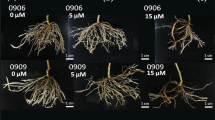Abstract
Cucumber seeds and seedlings at various ages (7–19 days old) were treated with a single treatment or multiple treatments (at 2-day intervals) of ferulic acid in nutrient culture. Ferulic acid treatments of cucumber seeds during stages of germination and radicle growth did not significantly reduce subsequent seedling growth. Ferulic acid treatments to seedlings reduced leaf area, leaf expansion, and dry weight of cucumber seedlings. Pretreatment of seeds and seedlings with 0.1 or 0.2 mM ferulic acid did not modify the effects of a single 1 mM ferulic acid treatment on leaf expansion when a single treatment was given at various times to seedlings ranging from 7 to 19 days of age. Treatments of 1mM or greater induced rapid wilting of leaves, but visible recovery occurred within 24–48 hr and subsequent treatments did not cause wilting. Once seedlings were removed from ferulic acid treatments, leaf expansion resumed. The magnitude of recovery depended on the concentration of ferulic acid, frequency of ferulic acid application and age of the seedling. Mean relative rates of leaf expansion recovered rapidly even in the presence of ferulic acid. Recovery of leaf expansion after ferulic acid treatments was faster for seedlings grown in an adequate nutrient environment than for seedlings grown in a limited nutrient environment. Ferulic acid disappeared from nutrient solutions with time, and two microbial metabolic products of ferulic acid (i.e., vanillic and protocatechuic acid) were identified in nutrient solutions.
Similar content being viewed by others
References
Bates-Smith, E.C. 1956. The commoner phenolic constituents of plants and their systematic distribution.Proc. R. Dublin Sci. 27:165–176.
Blum, U., Dalton, B.R., andRawlings, J.O. 1984. Effects of ferulic acid and some of its microbial metabolic products on the radicle growth of cucumber.J. Chem. Ecol. 10:1169–1191.
Dalton, B.R., Blum, U., andWeed, S.B. 1983. Allelopathic substances in ecosystems: Effectiveness of sterile soil components in altering recovery of ferulic acid.J. Chem. Ecol. 9:1185–1201.
Dagley, S. 1971. Catabolism of aromatic compounds by microorganisms, pp. 1–46,in A.H. Rose and J.F. Wilkinson (eds.). Advances in Microbial Physiology, Vol. 6. Academic Press, London.
Del Moral, R., andMuller, C.H. 1970. The allelopathic effects ofEucalyptus camaldulensis.Am. Midl. Nat. 83:254–282.
Einhellig, F.A., andKuan, L. 1971. Effects of scopoletin and chlorogenic acid on stomatal aperture in tobacco and sunflower.Bull. Torrey Bot. Club 98:155–162.
Einhellig, F.A., andRasmussen, J.A. 1979. Effects of three phenolic acids on chlorophyll content and growth of soybean and grain sorghum seedlings.J. Chem. Ecol. 5:815–824.
Evans, G.C. 1972, The Quantitative Analysis of Plant Growth. Blackwell Scientific, Oxford.
Evans, W.C. 1963. The microbial degradation of aromatic compounds.J. Gen. Microbiol. 32:177–185.
Flaig, W. 1964. Effects of microorganisms in the transformation of lignin to humis substances.Geochim. Cosmochim. Acta 28:1523–1533.
Guenzi, W.D., andMcCalla, T.M. 1966. Phytotoxic substances extracted from soil.Soil Sci. Soc. Am. Proc. 30:214–216.
Hall, A.B., Blum, U., andFites, R.C. 1983. Stress modification of allelopathy ofHelianthus annuus L. debris on seedling biomass production ofAmaranthus retroflexus.J. Chem. Ecol. 9:1213–1222.
Harper, J.P., andBalke, N.E. 1981. Characterization of the inhibition of K+ absorption in oat roots by salicylic acid.Plant Physiol. 68:1349–1353.
Helwig, J.T., andCouncil, K.A. (eds.). 1979. SAS Users Guide. SAS Institute Inc. Cary, North Carolina.
Hoagland, D.R., andArnon, D.I. 1938. The water-culture method of growing plants without soil.Calif. Agric. Exp. Stn. Circ. 347.
Lodhi, M.A.K. 1975. Soil-plant phytotoxicity and its possible significance in a bottomland forest.Am. J. Bot. 62:618–622.
Lodhi, M.A.K. 1976. Role of allelopathy as expressed by dominating trees in lowland forests in controlling the productivity and pattern of herbaceous growth.Am. J. Bot. 63:1–8.
Lodhi, M.A.K. 1978. Allelopathic effects of decaying litter of dominant trees and their associated soil in a lowland forest community.Am. J. Bot. 65:340–344.
Lodhi, M.A.K. 1979. Germination and decreased growth ofKochia scoparia in relation to its autoallelopathy.Can. J. Bot. 57:1083–1088.
Martin, J.P., andHaider, K. 1976. Decomposition of specifically carbon-14-labeled ferulic acid: Free and linked into model humic acid-type polymers.Soil Sci. Soc. Am. J. 40:377–380.
McPherson, J.K., Chou, C.-H., andMuller, C.H. 1971. Allelopathic constituents of chaparral shrubAdenostoma fasciculatum.Phytochemistry 10:2925–2933.
Olmstead, C.E., III, andRice, E.L. 1970. Relative effects of known plant inhibitors on species from first two stages of old-field succession.Southwest. Nat. 15:165–173.
Patterson, D.T. 1981. Effects of allelopathic chemicals on growth and physiological responses of soybean (Glycine max).Weed Sci. 29:53–59.
Radford, P.J. 1967. Growth analysis formulae—their use and abuse.Crop Sci. 7:171–175.
Rassmussen, J.A., andEinhellig, F.A. 1977. Synergistic inhibitory effects ofp-coumaric and ferulic acids on germination and growth of grain sorghum.J. Chem. Ecol. 3:197–205.
Rice, E.L. 1974. Allelopathy. Academic Press, New York.
Rice, E.L. 1979. Allelopathy—an update.Bot. Rev. 45:15–109.
Stowe, L.G., andOsborn, A. 1980. The influence of nitrogen and phosphorus levels on the phytotoxicity of phenolic compounds.Can. J. Bot. 58:1149–1153.
Turner, J.A., andRice, E.L. 1975. Microbial decomposition of ferulic acid in soil.J. Chem. Ecol. 1:41–58.
Wang, T.S.C., Yang, T., andChuang, T. 1967. Soil phenolic acids as plant growth inhibitors.Soil Sci. 103:239–246.
Whitehead, D.C. 1964. Identification of p-hydroxybenzoic acid, vanillic,p-coumaric, and ferulic acids in soils.Nature 202:417–418.
Whitehead, D.C., Dibb, H., andHartley, R.D. 1981. Extradant pH and the release of phenolic compounds from soils, plant roots and leaf litter.Soil Biol. Biochem. 13:343–348.
Whitehead, D.C., Dibb, H., andHartley, R.D. 1982. Phenolic compounds in soil as influenced by the growth of different plant species.J. Appl. Ecol. 19:579–588.
Williams, R.D., andHoagland, R.E. 1982. The effects of naturally occurring phenolic compounds on seed germination.Weed Sci. 30:206–212.
Author information
Authors and Affiliations
Additional information
Paper No. 9256 of the Journal Series of the North Carolina Agricultural Research Service, Raleigh, North Carolina. Mention of a trademark or proprietary product does not constitute a guarantee or warranty of the product by the Agricultural Research Service and does not imply its approval to the exclusion of other products that may be suitable.
Rights and permissions
About this article
Cite this article
Blum, U., Dalton, B.R. Effects of ferulic acid, an allelopathic compound, on leaf expansion of cucumber seedlings grown in nutrient culture. J Chem Ecol 11, 279–301 (1985). https://doi.org/10.1007/BF01411415
Received:
Accepted:
Issue Date:
DOI: https://doi.org/10.1007/BF01411415




